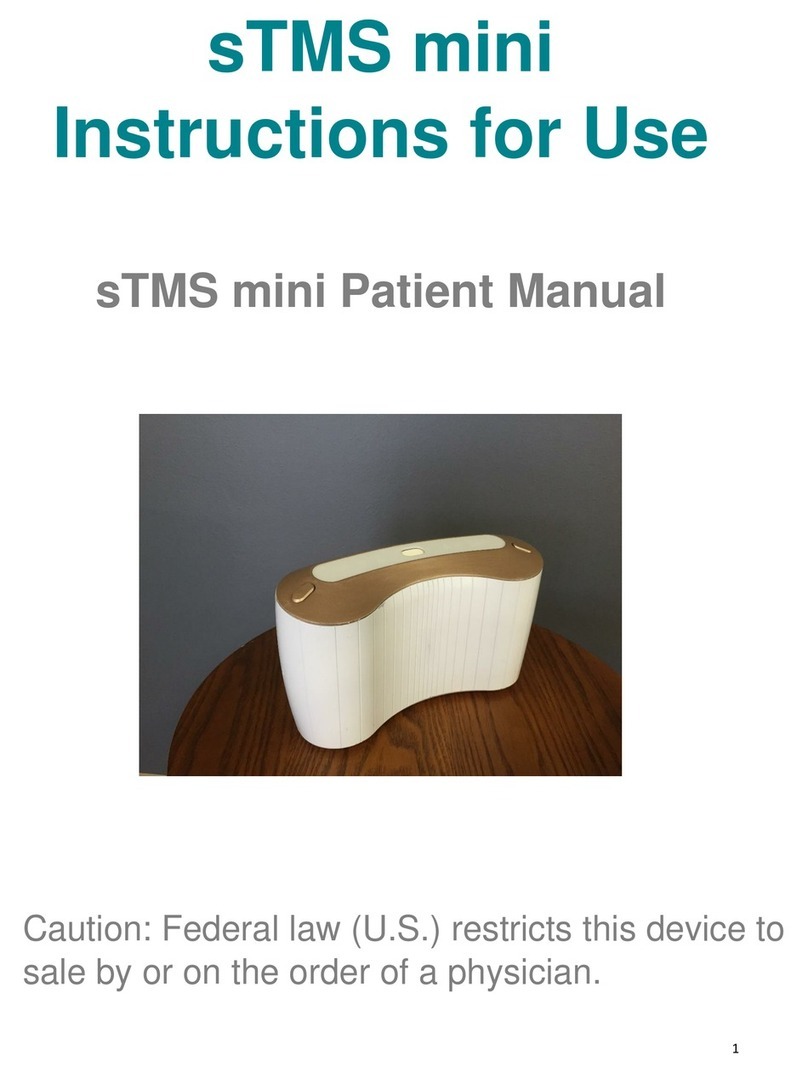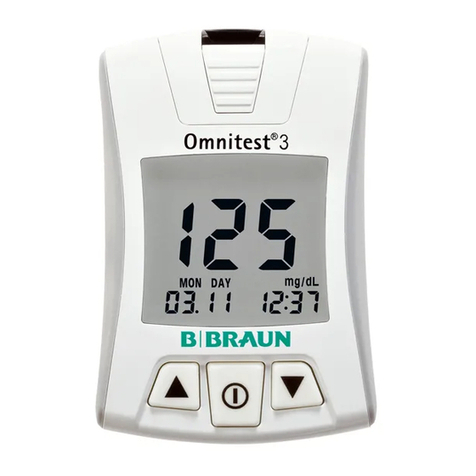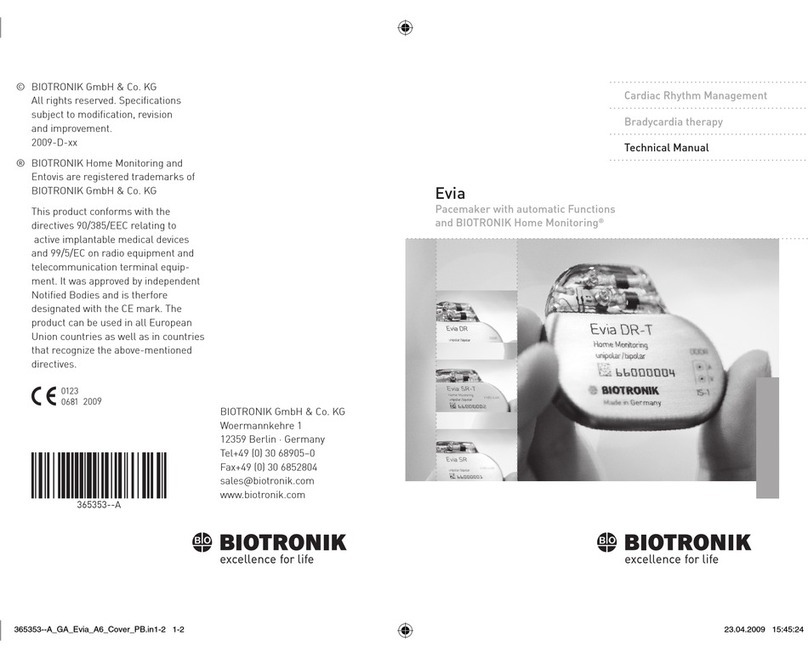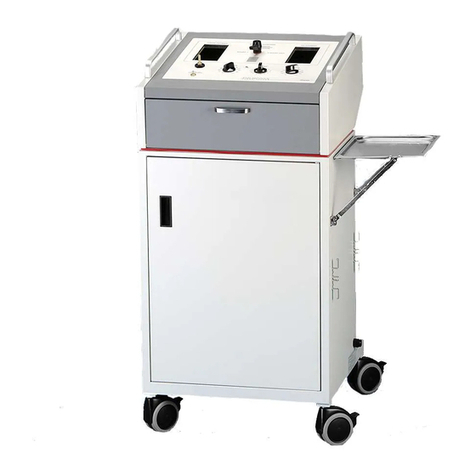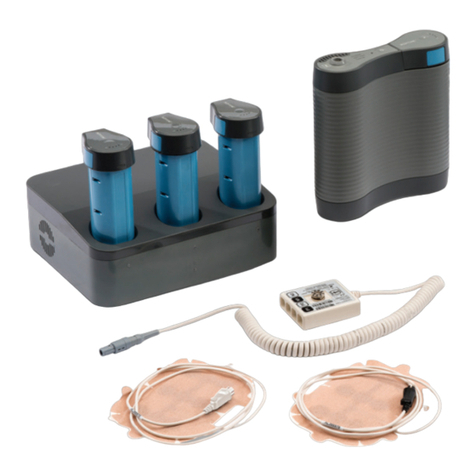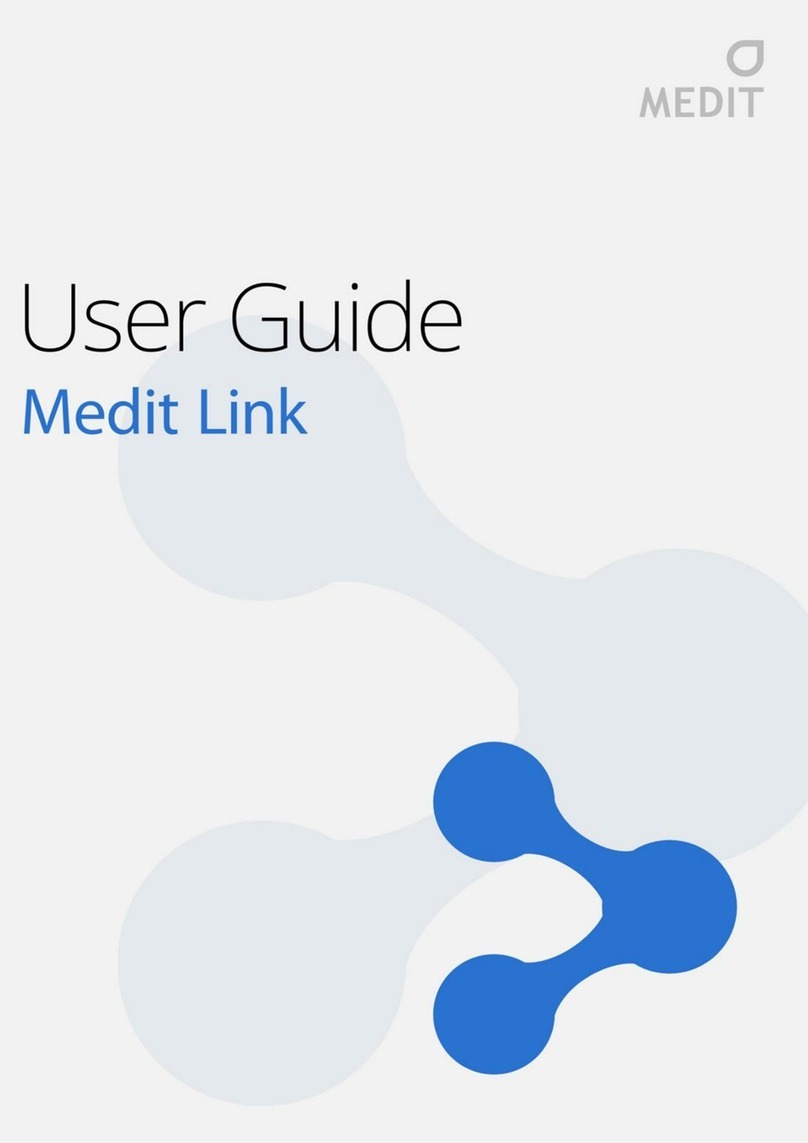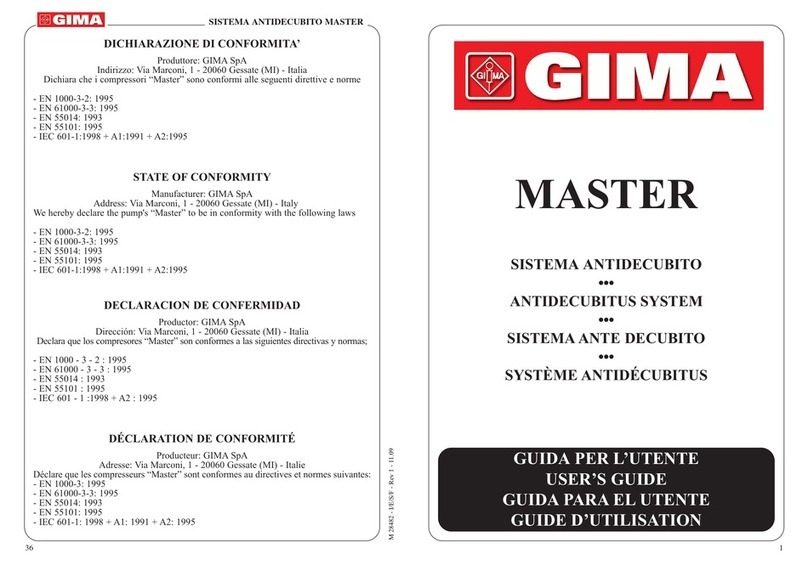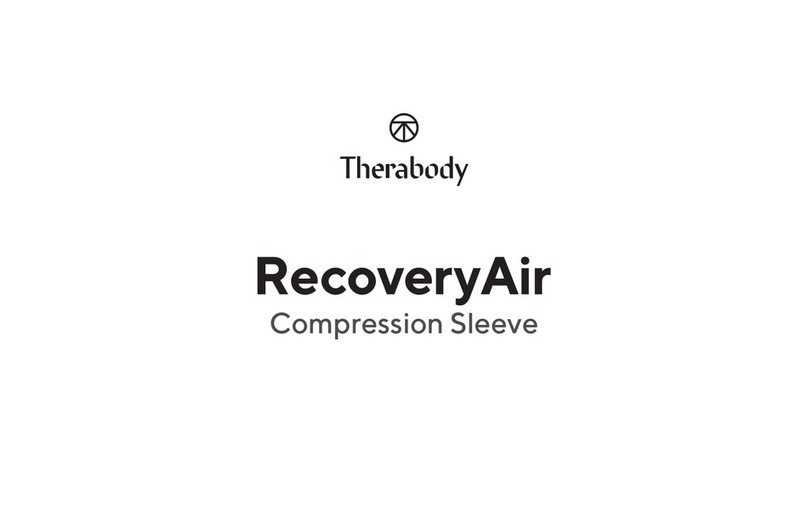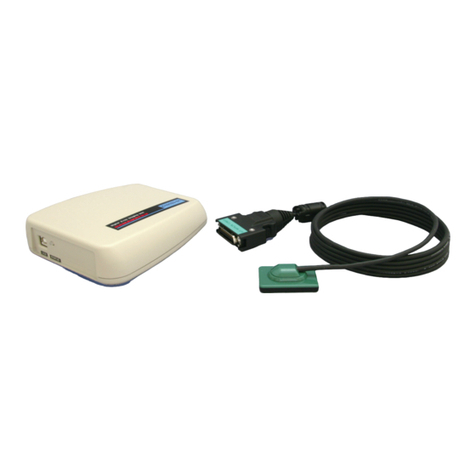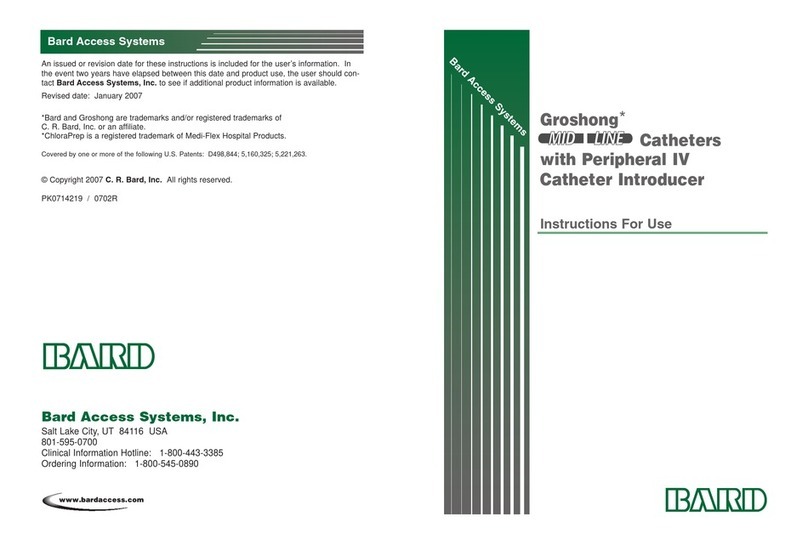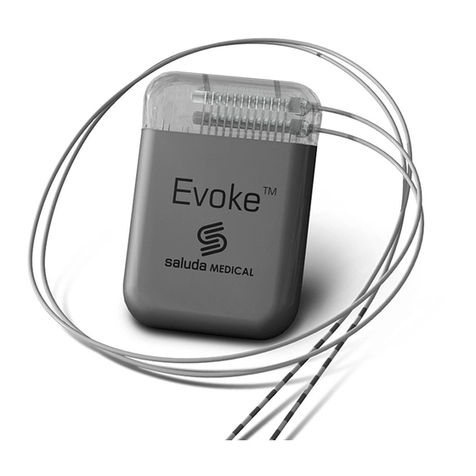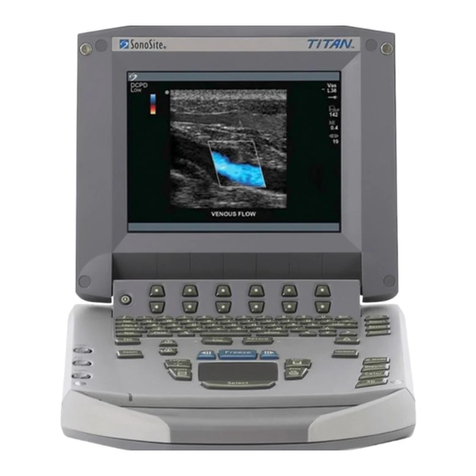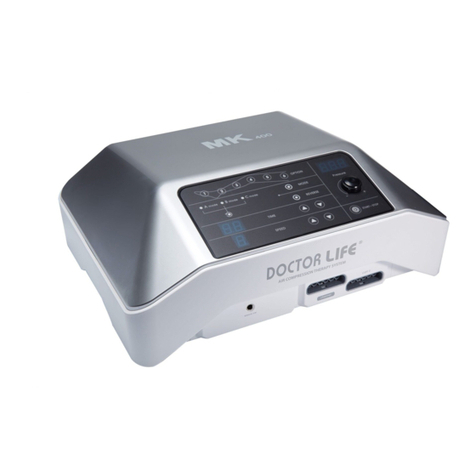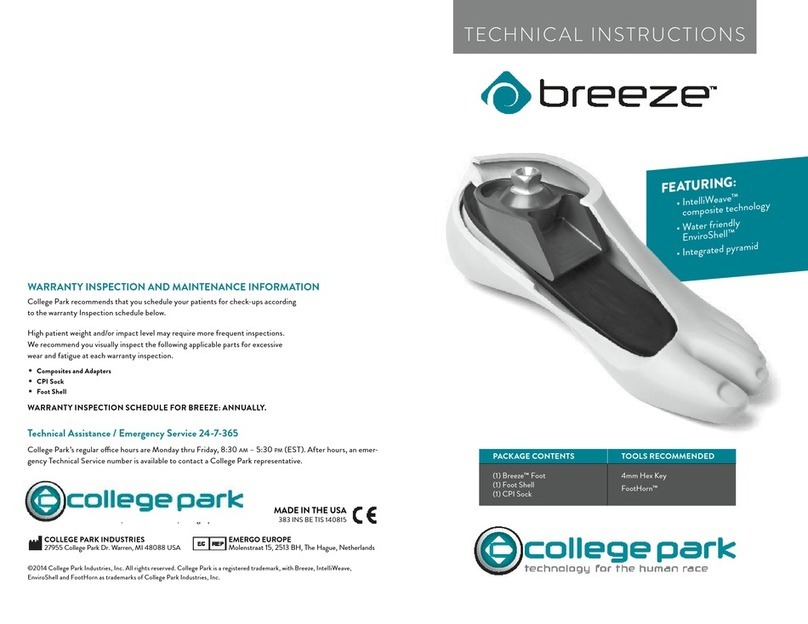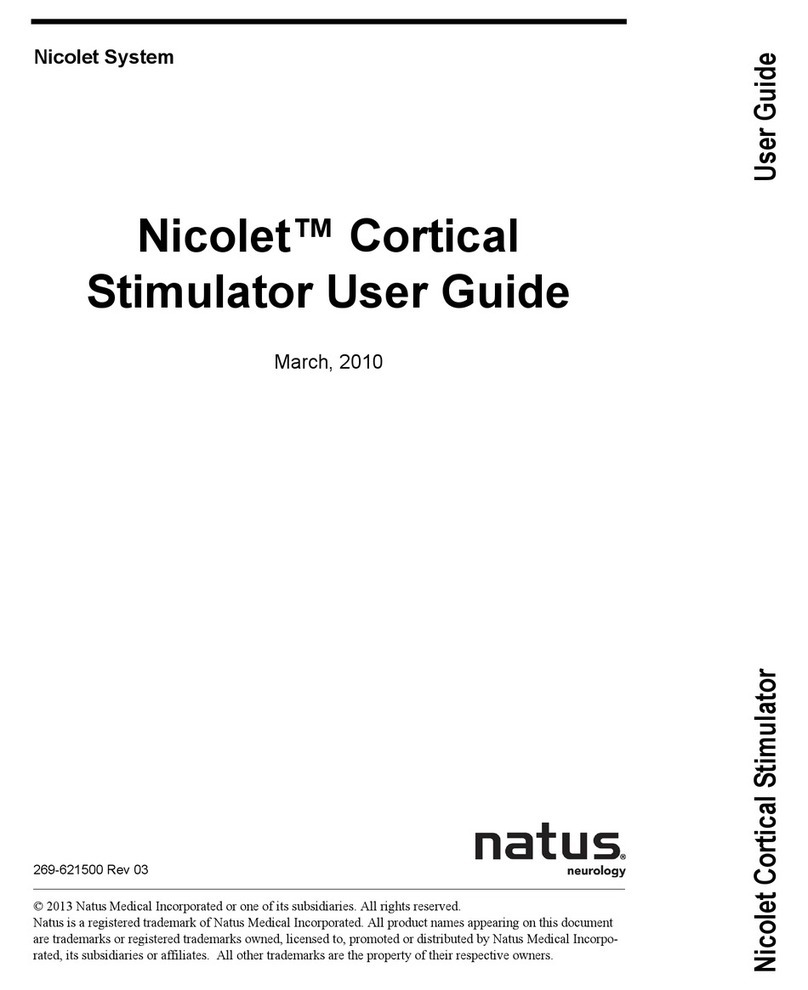eNeura SAVI User manual

1
SAVI™
Instructions for Use
SAVI Prescriber’s Manual
Caution: Federal law (U.S.) restricts this device to sale by or on the order of a physician.

2
Table of Contents
Before You Begin .........................................................................................................................................................3
Intended Use .................................................................................................................................................4
Warnings and Precautions ............................................................................................................................4
Contraindications ..........................................................................................................................................6
Clinical Trial and Adverse Reactions..............................................................................................................8
SAVI .............................................................................................................................................................11
Getting to Know the device .......................................................................................................................................12
Using the SAVI ...........................................................................................................................................................14
Setting Up the SAVI .....................................................................................................................................14
Recommended Treatment ..........................................................................................................................15
Preparing for Treatment .............................................................................................................................15
Positioning the Device.................................................................................................................................17
Delivering the Treatment ............................................................................................................................18
Renewing the Prescription ..........................................................................................................................18
Renewing a Prescription by optional Micro SIM Rx card ............................................................................19
Replacing the Micro SIM Rx card.................................................................................................................20
Additional Information ..............................................................................................................................................21
Traveling with the SAVI..............................................................................................................................................22
Caring for the SAVI.....................................................................................................................................................22
Understanding System Display Messages .................................................................................................................23
Troubleshooting ........................................................................................................................................................24
Service .........................................................................................................................................................25
Return Goods Policy ....................................................................................................................................25
Technical Specifications.............................................................................................................................................25
Operating Environment .............................................................................................................................................26
Storage Environment...................................................................................................................................26
Industry Standard Classification..................................................................................................................26
REACH and Warning Statement ..................................................................................................................27
EMC Compliance and Warning Statement..................................................................................................27
EMC Guidance .............................................................................................................................................27
EMC Guidance (continued)........................................................................................................................................29
Glossary of Abbreviations..........................................................................................................................................32
Medical Device Reporting..........................................................................................................................................33
Warranty and Limitation of Liability..........................................................................................................................33
Customer Care Contact Information .........................................................................................................................33

3
Before You Begin
This manual provides the information you need to prescribe the eNeura SAVI to your patients. You will see cautions, warnings, and
helpful information placed near the related steps. Call Customer Care if you don’t understand something in this manual.
Before prescribing the SAVI to your patients, you will be trained on the contents of this manual, including use, patient selection,
contraindications, warnings and precautions by an eNeura representative. The eNeura representative will also demonstrate the
device according to the Physician Manual.
Please read this entire manual thoroughly before prescribing the SAVI. Review the contraindications, cautions, warnings and notes
regarding the use of the device. As the manufacturer, eNeura cannot and does not intend to give medical advice. This manual must
be available for your reference when discussing the device with your patients.
eNeura is committed to the service and support of our customers.If there are any questions about the use of the eNeura SAVI,
please contact Customer Care or your local representative at the following:
Manufactured by: eNeura Inc.
101 W. Dickman Street, Ste 900
Baltimore, MD 21230 USA
eNeura Inc.
Corporate Headquarters
101 W. Dickman Street, Ste 900
Baltimore, MD 21230 USA
Tel: +1 408.245.6400
Toll free (USA only): +1 833.499.9300
Fax: +1 877.264.1818
www.eNeura.com
info@eNeura.com
customercare@eNeura.com
eNeura (UK) Ltd.
6th Floor
One London Wall London EC2Y 5EB
United Kingdom
www.eNeura.co.uk
Tel. +44 (0) 20.3356.4889
Fax: +44 (0) 20.7785.8152
customercare@eneura.co.uk
Authorized Representative
Emergo Europe BV
Prinsessegracht 20
2514 AP The Hague
The Netherlands
Tel: +31 (0) 70.345.8570
Fax: +31 (0) 70.346.7299
www.emergoeurope.eu
Australia Sponsor
Emergo Australia
Level 20, Tower II, Darling Park
201 Sussex Street
Sydney, NSW 2000
Australia
www.emergogroup.com

4
Intended Use
The SAVI (The System) is indicated for the acute and prophylactic treatment of migraine headache in adolescents (age 12 and older)
and adults.
The System is intended for self-treatment and delivers a non-invasive, brief, single pulse of magnetic energy to the back of the head.
This creates a brief electrical current in the brain intended to stop or reduce the effects of migraine headaches.
The System is a drug-free treatment option that can be used in the home or away from home. The patient should use the device
based on your instructions.After treatment, there are no restrictions.Patients can resume their normal activities.
WARNING: This device should be used under your continued supervision of the patient.
Instruct the patient to keep the SAVI out of the reach of children.
Safety and effectiveness have not been established in pregnant women and in children under the
age of 12.
The long-term effects of single-pulse transcranial magnetic stimulation are unknown.
Warnings and Precautions
The words WARNING, Precaution and NOTE have special meanings in this manual. Read them throughout the manual to ensure
the safe and effective use of your SAVI.
WARNING: A WARNING tells you that the personal safety of the patient may be involved. Ignoring a
WARNING could result in injury to the patient. WARNINGS in the manual are shown in an orange box.
Precaution: A Precaution means that exact steps must be followed to prevent damage to the product.Precautions
in the manual are shown in a purple box.
NOTE: ANOTE gives special information to ease product use or to explain important information. NOTES
in the manual are shown in a dashed box.

5
WARNING: The SAVI should be used only under your continued supervision of the patient.Advise
the patient that the System has been prescribed only to be used by him or her. Patients must be
aware that the device is non-transferable and that failure to follow this instruction could result in
minor to serious injury, including death, to the patient and the unintended user.
Inspect the System for any signs of damage before use. Advise the patient to not use it if it is cracked
or wet.If you or your patient suspect damage to the device, call eNeura at: +1 833.499.9300 option
1 for assistance.
Do not operate the System in or near an area where explosive gases are being used or have been
used. Do not operate near gasoline or natural gas.
Do not operate the System in or near the presence of a FLAMMABLE ANESTHETIC MIXTURE WITH
AIR or WITH OXYGEN or NITROUS OXIDE.
Risk of electrical shock. Do not open the System. There are no parts that can be serviced or replaced
by the user. High voltage may be present.
Risk of electrical shock. Do not allow the System or power cords to get wet. Quickly wipe up spills
on or near the SAVI.Do not use the System in or near water. For example, do not use while in the
bathtub or shower, in the rain, or while standing in water or on a wet surface.
Instruct your patients that the System should not be used if the cause of the headache is illness,
underlying pathology, trauma or overuse of medication.
TMS treatments should not be used in patients with suspected or diagnosed epilepsy or a personal
or family history of seizures. Prior to prescribing eNeura SAVI, carefully review your patient’s history
for a family history of epilepsy or seizures; patient history of a head trauma or head injury or a
current prescription for any medication such as tricyclic antidepressants, neuroleptic agents, or other
drugs that lower the seizure threshold.
TMS treatment should not be used if the patient has a history of stroke.
The System has not been demonstrated as safe or effective when treating cluster headache.
TMS treatments should not be used on patients who use a wearable cardioverter defibrillator (WCD).
The long-term effects of chronic magnetic stimulation are unknown.
Transcranial magnetic stimulation should only be applied to the back of the head as described in the
“Using the Device” section of this manual.
Instruct your patient that the eNeura SAVI should not be used to stimulate over the front of the neck
or mouth.Severe spasm of the laryngeal and pharyngeal muscles may occur and the contractions
may be strong enough to close the airway or cause difficulty in breathing.
Instruct your patient that the eNeura SAVI should not be used to stimulate over the upper side of
the neck.Stimulation of the carotid sinus nerves, particularly in patients with a known sensitivity to
the carotid sinus reflex, could result in a sudden drop in blood pressure, slowing of the heart or loss
of consciousness.
Instruct your patient that the eNeura SAVI should not be used to stimulate the chest or back. The
induction of electrical current into the heart may cause cardiac arrhythmias.

6
Contraindications
WARNING: Failure to follow the restrictions listed below could result in serious injury or death.
The SAVI creates a very strong single-pulse magnetic field. The System should be used only under your continued supervision of the
patient. Advise the patient that the device has been prescribed only for use by him or her. The System may not be used in patients
who have metals, conductive materials, or metal-containing implants in their head, neck or upper body. Metals and conductive
materials can be affected by a magnetic field. Discuss this thoroughly with your patient before prescribing the device.
Patients MUST NOT use the System if they have a cardiac pacemaker, vagus stimulator (VNS) or other implanted neurostimulator,
implanted cardioverter defibrillator (ICD) or any implanted medical device that stimulates the body or uses any signal from the body.
Do not prescribe the device to these patients.
If your patient has implants that are affected by a magnetic field, he or she MUST NOT be prescribed the use of the System. Failure
to follow this restriction could result in serious injury or death. Examples of such implants include:
•Aneurysm clips or coils
•Cochlear implants
•Cerebral spinal fluid shunts
•Bullets or pellets lodged in the head or upper
body
•Metal plates, screws, staples or sutures in
skull, neck, shoulders, arms or hands
•Radioactive seeds
•Magnetically programmable shunt valves
•Stents
•Filters
•Metallic artificial heart valves
•Facial tattoos with metallic ink
•Electrodes
Dental implants, fillings or other dental appliances are okay and are not affected by the device.
Advise your patient to inform you if following your prescription, he or she will require an intervention that includes implantation of
any device or other object. In such case, verify whether the implant will contain any conductive substances. If so, instruct your
patient to discontinue use of the System.

7
WARNING: Instruct your patient that the eNeura SAVI should not be used while driving, operating
machinery or during any activity in which involuntary muscle contractions may put the user at risk of
injury.
Instruct your patient to stay at least 2 feet (0.6 meter)from others when using the System.The
System could be harmful to anyone with an electronic implant such as a pacemaker. Anyone with a
hearing aid or cochlear implant may hear an audible click.
The device could be disrupted by RF-emitting equipment including wireless home network devices,
mobile phones, cordless telephones and their base stations and walkie-talkies. See “EMC Compliance
and Warning Statement” section for additional information on preventing unwanted interference.
•Precaution: Instruct your patient to keep the System away from other electronic devices that depend-on
(receive) or radiate (transmit) radio frequency energy, when it is powered on.
•The operation of the System may be impaired when operated near home devices such as wireless network
routers, mobile phones, cordless telephones and their base stations and walkie-talkies. Keep the SAVI device at
least 2 feet (0.6 meter) from these devices when it is powered on and in use.
•Instruct your patient to keep credit cards, audio/video tapes, computers, computer disks, flash memory sticks,
cell phones, personal digital assistants (PDAs), MP3 players, headphones, digital cameras, portable glucose
meters and other electronic devices or electronic storage media more than 2 feet (0.6 meter) away from the
System when it is in use.
•Instruct your patient to keep any loose metal objects such as eyeglasses, keys, coins, jewelry, watches and hair
clips more than 2 feet (0.6 meter) away from the System when it is in use.
•Instruct your patient to keep wearable medical devices such as insulin pumps, medicinal pumps, monitors, bone
grow stimulators and Transcutaneous Electrical Nerve Stimulator (TENS) devices more than 2 feet (0.6 meter)
away from the System when it is in use.
•Safety and effectiveness have not been established in pregnant women and in children under the age of 12.
•The long-term safety and effectiveness of the eNeura device has not been demonstrated in adolescents
12-17 years of age. Due to hormonal and cognitive development changes in adolescents, this
population should be closely monitored while using the device. The use of the device in this population
is based on extrapolated data from a clinical study in adults.
•Caution should be used for patients with suspected or diagnosed heart problems.
•The System is only intended to be serviced or maintained by the manufacturer. Do not attempt to open the
device.The warranty may be invalidated. If the device is opened, contact eNeura at: +1 833.499.9300 option 1.
•Instruct your patient to keep the System out of the reach of children.
•Side effects can include minor dizziness, nausea, vomiting, application site tenderness, muscle spasm, headache
and migraine.
•Special precautions regarding Electromagnetic Compatibility (EMC) are required when installing and using the
System. Portable and mobile communications devices can affect proper operation of the System. See “EMC
Compliance and Warning Statement” section of the Instructions for Use for more information.
•Advise your patient that the eNeura SAVI should be installed and put into service according to the EMC
information provided in this Physician Manual.
•Advise your patient to see “EMC Compliance and Warning Statement” section of the Patient Manual for more
information.

8
Clinical Trial and Adverse Reactions
Summary of Clinical Data:
eNeura sTMS Post-Market Observational U.S. Study of Migraine(“ESPOUSE”).
A Multi-Center, Prospective, Non-Randomized, Single Arm, Open Label, Post-Market, Observational Study to evaluate the Use of
the eNeura, sTMS System in reduction of Migraine Headache symptoms
eNeura completed a prospective, single-arm, non-randomized NSR clinical study in United States centers of excellence designed to
establish safety and effectiveness for use of the eNeura device for migraine headache treatment and prevention. The effectiveness
control for this study population was a performance goal derived from the literature of patients with similar migraine frequency with
respect to the number of reduced headache days in 12 weeks in placebo or sham patients of randomized clinical trials. Baseline
medication and symptoms were recorded for 28 days via patient diary. Patients were instructed to treat daily using the following
protocol with no change in preventive medication and to complete Month 1, 2, and 3 diaries.
Six patients reported using prophylactic medications at baseline (2.8%), of these, 5 were using topiramate and propranolol.
The efficacy of the eNeura device for prophylactic treatment is based on the result of an open label study. In open label studies, bias may
affect the result. Additionally, open-label studies may introduce placebo rates of 10-25%. This is consistent with placebo rates reported
in Randomized Controlled studies for migraine prevention.*
ESPOUSE Treatment Protocol:
Treat with 4 Pulses each morning and evening:
2 consecutive pulses wait 15 minutes and repeat the 2 consecutive pulses.
Additionally, the patient may treat an acute attack with:
3 sequential pulses (early) at the onset of migraine pain
Wait 15 minutes
If needed treat with additional 3 pulses
Wait 15 minutes
If needed treat with additional 3 pulses
Patients could rescue with acute medication 30 minutes after the first three pulses are delivered.
A total of 263 subjects were consented between December 2014 and March 2016. 229 of these completed a Baseline Diary and 220
were confirmed by the sites to be eligible for participation. There were 217 subjects that were assigned an active eNeura device and
these subjects comprise the Safety Data Set. There were 179 subjects who began treatment and completed a Month 1 treatment
diary, but 47 of these subjects did not meet the minimum requirement of at least 4 days with moderate to severe headache pain for
at least 4 hours at baseline. Thus, 132 of these subjects complied with the protocol requirements based upon headache day
definition. This was the Full-Analysis Data Set (FAS) described below. There were 117 of these subjects that went on to finish
treatment and completed both baseline and Month 3 diaries. This was the Completed Cases data set (CC). Of these subjects, 95
complied with the protocol instructions regarding use of the device. This was the Per Protocol (PP) data set.
*Macedo A, Banos JE, Farre M. Placebo response in the prophylaxis of migraine: a meta-analysis. Eur J Pain 2008; 12;68-75

9
Primary End Point:Study results showed statistically significant reduction in migraine headache days of 2.8 days (from a baseline
mean of 9.1 days) (FAS), P<0.0001; 2.8 days (from a baseline mean of 8.9 days) (CC) P<0.0001, and 3.0 days (from a baseline mean of
9.1 days) (PP) P<0.0001.
First Secondary Endpoint: Of the 117 subjects in the CC group, 54 (46.15%) had a
50% or greater reduction in headache days at three months, P<0.0001.
Second Secondary Endpoint: Reduction in acute medication days.
Reduction in Acute Medication Days in in Three Months
Endpoint
Baseline
Mean, (SD) N
Med (Min,
Max)
Change
Mean, (SD)
N
Med (Min,
Max)
95%
Confidence
Interval
t-statistic
P-value
Acute
Medication
Days (CC)
9.95 (5.63)
117
10.0 (0, 28)
-2.93 (5.24)
117
-2.0 (-23, 10)
(-3.89, -1.97) -6.05 <0.0001
Acute
Medication
Days (PP)
10.38 (5.76)
95
10 (0, 29)
-3.18 (5.45)
95
-3 (-23, 9)
(-4.29, -2.07) -5.69 <0.0001
Third Secondary Endpoint: The reduction from baseline in the HIT6 impact questionnaire
quality of life (HIT-6) improvement of 3.1 (CC) and 3.6 (PP).
Reduction in HIT 6 Score at Three Months
Endpoint
Baseline
Mean, (SD) N
Med (Min,
Max)
Change
Mean, (SD)
N
Med (Min,
Max)
95%
Confidence
Interval
t-statistic
P-value
HIT6 (CC)
63.85 (4.56)
117
64.0 (50, 76)
-3.10 (6.42)
114a
-2.0 (-25, 11)
(-4.29, -1.90) -5.15 <0.0001
HIT6 (PP) 64.04 (4.56) 95
64 (52, 76)
-3.63 (6.79)
94b
-2 (-25, 11)
(-5.02, -2.24) -5.18 <0.0001
Additional Disability measure MSQOL.
Increase in MSQOL Domain Scores at Three Months
Endpoint
Baseline
Mean, (SD) Na
Med (Min,
Max)
Change
Mean, (SD) Na
Med (Min,
Max)
95%
Confidence
Interval
t-statistic
P-value
MSQOL RR
(CC)
42.49 (19.69)
116
42.86 (0,
91.43)
16.12 (24.54)
113
17.14 (-48.57,
80.00)
(11.55, 20.70) 6.98 <0.0001
MSQOL RP
(CC)
59.45 (23.51)
116
62.5 (0, 100)
12.55 (25.23)
113
10.0 (-50,
100)
(7.85, 17.25) 5.29 <0.0001
MSQOL EF
(CC)
48.16 (27.94)
112
46.67 (0, 100)
16.40 (29.01)
113
13.33 (-40,
100)
(10.99, 21.81) 6.01 <0.0001
MSQOL RR
40.09 (19.85)
18.97 (24.90)
(13.85, 24.10)
7.35
<0.0001

10
(PP)
94
40 (0, 91.43)
93
20 (-48.57,
80)
MSQOL RP
(PP)
56.54 (24.30)
94
60 (0, 100)
14.84 (26.47)
93
10 (-50, 100)
(9.39, 20.29) 5.41 <0.0001
MSQOL EF
(PP)
44.26 (27.89)
94
40 (0, 100)
19.43 (29.22)
93
20 (-40, 100)
(13.41, 25.44) 6.41 <0.0001
Fourth secondary endpoint: The reduction from baseline in the days with
headache for more than 4 hours with any pain intensity.
Reduction in Headache Days Three Months
Endpoint
Baseline
Mean, (SD) N
Med (Min,
Max)
Change
Mean,
(SD) N
Med (Min,
Max)
95%
Confidence
Interval
t-
statistic
P-value
Headache
Daysa(CC)
10.58 (4.33)
117
10.0 (4, 24)
-3.16
(5.21) 117
-4.0 (-22,
9)
(-4.12, -
2.21) -5.25 <0.0001
Headache
Daysa(PP)
10.79 (4.32)
95
10 (4, 24)
-3.28
(5.16) 95
-4 (-22, 9)
(-4.34, -
2.23) -5.01 <0.0001
Safety: Approximately 29% of the 217 subjects included in the Safety Dataset
reported experiencing at least one adverse event in this study. No subject had
events that could be determined to be serious adverse events. None of the
events required treatment. Adverse events as described below are the same as
those reported in previous studies.
Adverse Events Reported in the ESPOUSE Study (greater than 2%)
Adverse Event
x/n (%)
95% LCL,
95%UCL
Reported Relationship to Device
Any
62/217
(28.57)
22.66, 35.08
19 Not related, 27 Possibly, 7 Probably,
5 Definitely, 4 Not Specified
Headachea
5/217
(2.30)
0.75, 5.30 1 Not related, 4 Possibly
Scalp Discomforta
5/217
(2.30)
0.75, 5.30 1 Possibly, 4 Probably
Tinglinga
7/217
(3.23)
1.31, 6.53
2 Possibly, 3 Probably, 1 Definitely,
1 Not Specified
Light Headednessa
8/217
(3.69)
1.61, 7.14 1 Not related, 6 Possibly, 1 Probably
Discomfort from
Noisea
5/217
(2.30) 0.75, 5.30 Not related, 2 Possibly, 2 Definitely
Dizziness
6/217
(2.77)
1.02, 5.92 5 Possibly, 1 Definitely
Ringing in Ears
(Tinnitus)
7/217
(3.23) 1.31, 6.53 1 Not Related, 6 Possibly
Worsened Headache
Pain
5/217
(2.30) 0.75, 5.30 3 Possibly, 2 Not specified

11
SAVI
The complete SAVI includes this manual and the following items:
The battery-powered, rechargeable device
Carrying bag for SAVI and its AC adapter battery charger
Note: The carrying bag is part of the packaging for shipping
the SAVI device. Please place the device into the bag prior to
boxing the device for return/exchange.
Battery Charger 12V DC 1.5A 18 watts
(reorder no.DWG-0505)
NOTE: Do not discard the box or packing materials. They will be
required if you need to return this product.

12
Getting to Know the device
A. Power Button In the center of the panel on the top of the System.Press the power button to turn the device on and
off.
B. Power Indicator LED light on the top of the System inside the Power button. Static white illumination shows the device is
on and ready.Pulsing blue illumination indicates device is connecting to the cellular network to transfer data.
C. Treatment Progress Indicator LED light around the power button on the top of the System, shows status as it prepares
for treatment.
D. Prescription Status Indicator Located on left side on the top of the System. Confirms a valid prescription is available and
shows the status of the prescription: White illumination indicates Rx is active; static orange indicates Rx will expire soon; orange
with orange Power Button indicates Rx has expires.
E. Contact eNeura Customer Care Action required. Call Customer Care.
F. Temperature warning The device temperature is not in range for safe use.
G. Lock Indicator On the right of the Power button.Indicator is visible when device is turned on if the security lock switch is
enabled.
H. AC Adapter On the right of the Power button. Indicator is lit when the AC adapter is connected to the device.
I. Battery Capacity On right side on the top of the System. Indicates whether or not battery power is enough to allow
treatment. White illumination indicates battery power is available; orange illumination indicates battery power will soon be
exhausted.
J. Treatment Buttons On the right and left edge of the panel on the top of the device. Press one or both buttons to deliver a
treatment.
Read “Understanding System Display Messages” for more information.
A
B
C
F
G
H
I
J
D
E

13
Battery Charger (Power Supply) and Micro SIM Rx card Ports
K. Lock ON/OFF Switch –Located behind accessory port door, on the left. Slide the switch to the left or right to unlock or lock the
device
L. Volume ON/OFF Switch – Located behind accessory port door, on the right. Slide the left or right to turn the sound on or off
M. Battery Charger Port – Located behind accessory port door, in the center. Recharge the batteries by plugging the AC battery
charger, DWG-0505, into this port
AC battery charger 12V DC
1.5A 18 watts
(reorder no.DWG-0505)
Plug that connects to
the System
N. Micro SIM Rx card port – Located on the back of the System beneath the Accessory Door. Insert the micro SIM RX card into this
port.
•Precaution: Use only eNeura-supplied accessories with the SAVI: Battery charger (reorder no. DWG-0505) and
Micro SIM Rx card.
M
N
L
K
Door side of device, with door open

14
Using the SAVI
•Precaution: Instruct your patient that this manual must be completely read and understood prior to use of the
SAVI.Improper use may cause personal injury and damage to the System and may void the warranty.
•Instruct your patient to become familiar with the functions and features of the device prior to use.
Setting Up the SAVI
Instruct the patient to be prepared to treat his or her migraine when needed.Instruct the patient to set up the SAVI as soon as it
arrives and keep the device charged and ready to treat.
NOTE: Instruct the patient to use only as directed.
Instruct the patient to use the device as follows:
Remove the System and the battery charger from the box.
NOTE: Instruct the patient to not discard box or packing materials. They will be required if there is a need
to return this product.
The device should arrive ready to use. If it is not ready, plug the battery charger into a standard wall outlet. Connect the other
end of the battery charger to the port on the device. Charge the battery for about 4 to 6 hours.
Treatment delivery is not available during battery charging.
If the device is on while charging, the AC adapter symbol and the battery capacity symbol will be lit.
Unplug the battery charger when the device is fully charged. A fully charged battery should deliver at least 12 treatments.
Keep the accessory door closed when not in use.
Store the device and its battery charger in a cool, dry place, away from excessive dust and direct sunlight.
•Precaution: Only use the battery charger (DWG-0505) included with the SAVI.Contact eNeura if you have any
questions.

15
Recommended Treatment
The treatment with the SAVI should be performed per your instructions as the prescribing physician. Read the instructions below
prior to operating the device. When discussing the treatment with the patient, emphasize the importance of following your
instructions, the instructions in the Patient Manual and adhering to the prescribed treatment regimen. Review the instructions
below with your patient.
Prevention
Treat with 4 pulses each morning and evening
2 consecutive pulses
Wait 15 minutes
Repeat the 2 consecutive pulses
Acute
3 sequential pulses (early) at the onset of migraine pain
Wait 15 minutes
If needed, treat with additional 3 pulses
Wait 15 minutes
If needed, treat with additional 3 pulses
NOTE: Instruct your patient to become familiar with the System and how to use it before he or she experiences a
migraine.
Preparing for Treatment
Consult with your patient about his or her specific condition and the best timing of sTMS treatment.
•Precaution: Instruct your patient to keep the System away from other electronic devices that depend on
(receive) or radiate (transmit) radio frequency energy, when it is powered on.
•The operation of the System may be impaired when operated near home devices such as wireless network
routers, mobile phones, cordless telephones and their base stations and walkie-talkies. Keep the SAVI device at
least 2 feet (0.6 meter) from these devices when it is powered on and in use.
•The System emits a strong magnetic pulse that may interfere with the operation of common home electronic
devices such as radios, televisions, wireless network routers, mobile phones, cordless telephones and their base
stations and walkie- talkies, if they are not installed and used in accordance with the manufacturer’s
instructions. There is no guarantee that interference will not occur in a particular installation.If the System
causes interference with other devices, try to correct the matter by:
•Reorienting or relocating the device receiving the interference.
•Increase the separation distance between the System and the device.
•Connect the System to an AC outlet on a circuit different from that to which the other device is
connected.
Use the System in a comfortable, seated position. Remove the System from its storage location.
WARNING: Inspect the System for any signs of damage before use.Advise your patient to not use if it is
cracked or wet.If you suspect damage to the device, call eNeura at +1 833.499.9300 option 1 for
assistance.
The System needs to be in direct contact with the back of your head to work properly.Before treatment, remove any hat, head
covering, or hairpiece that covers the back of your head and undo any braids, ponytails or buns.

16
WARNING: Remove any personal medical devices such as insulin pumps or other medical pumps and bone
growth stimulators.
Press the power button
Watch the LED track light progress around the power button:
It takes 30-60 seconds to prepare the System for treatment.
As the device prepares for treatment, each segment will light up to indicate progress.
When the system is ready, the device lights up all 6 segments and sounds an audio tone:
Once the System is ready, you have 45 seconds to position the device and deliver treatment.
WARNING: Instruct your patient to stay at least 2 feet (0.6 meter)from others when using the SAVI. This
device could be harmful to anyone with an electronic implant such as a pacemaker.
Remove any personal medical devices such as insulin pumps, other medicinal pumps, bone growth
stimulators, Transcutaneous Electrical Nerve Stimulator (TENS) devices and hearing aids.
Do not use the System on patients who use a wearable cardioverter defibrillator (WCD).
Instruct your patient that the System should not be used while driving, operating machinery or during any
activity in which involuntary muscle contractions may put you at risk of injury.
Risk of electrical shock: Do not allow the System or power cords to get wet. Advise your patient to quickly
wipe up spills on or near the device. Do not use the device in or near water. For example, do not use while
in the bathtub or shower, in the rain or while standing in water or on a wet surface.
Do not operate the System in or near an area where explosive gases are being used or have been used. Do
not operate near diesel fuel, gasoline or natural gas.
Do not operate the System in or near the presence of a FLAMMABLE ANESTHETIC MIXTURE WITH AIR or with
OXYGEN or NITROUS OXIDE.
Instruct your patient that the System should not be used if the cause of the patient’s headache is illness,
trauma or excess medication. Consult your doctor if you are unsure.
Do not use the System in patients with suspected or diagnosed epilepsy. Consult your doctor before using
the System if a family member has epilepsy. Prior to prescribing the SAVI, carefully review your patient’s
history for a family history of epilepsy, seizures, head trauma or head injury, or if the patient is currently using
any medication such as tricyclic antidepressants, neuroleptic agents or other drugs that lower the seizure
threshold.
Do not use the System if the patient has a history of stroke.
Caution should be used for patients with suspected or diagnosed heart problems.

17
•Precaution: Keep the SAVI away from metal or conductive objects, medical devices and magnetic media when it
is powered on.
•When activated, the System emits a strong magnetic pulse and may interfere with other metal, electronic or
magnetic products within 2 feet (0.6 meter). A person with a hearing aid or cochlear implant may hear a click
when the System is activated.
•The operation of the SAVI System may be impaired when operated near home devices such as wireless network
routers, mobile phones, cordless tele- phones and their base stations, and walkie-talkies. Keep the SAVI device
at least 2 feet (0.6 meter)from these devices when it is powered on and being used.
oInstruct your patient to move credit cards, audio/video tapes, computers, computer disks, flash
memory sticks, cell phones, personal digital assistants (PDAs), MP3 players, headphones, digital
cameras, portable glucose meters and other electronic devices or electronic storage media more
than 2 feet (0.6 meter) away from the System.
oInstruct your patient to remove all metal objects from your head, face, neck, arms and hands.Remove
eyeglasses, hearing aids, removable metallic orthodontic appliances, hair clips and earphones and move
them more than 2 feet (0.6 meter) away from the System.
oInstruct you patient to remove any loose metal objects from your shirt pockets such as keys, coins, clips,
pens and mechanical pencils and move them more than 2 feet (0.6 meter) away from the System.
Positioning the Device
With the SAVI in front of the patient: The treatment buttons should be facing up and the accessory door should be facing away
from the patient. The patient places both hands on the sides of the device with thumbs on the treatment buttons.
The patient lifts the System over his or her head. The device should be placed so that it comfortably and naturally cradles the
base of the skull.The patient should hold it firmly against his or her head.
The curved surface positions the device to fit comfortably against the head and optimize pulse delivery.

18
WARNING: Transcranial magnetic stimulation should only be applied to the back of the head as described in
the “Positioning the Device” section of this manual.
Instruct your patient that the System should not be used to stimulate over the front of the neck or mouth.
Severe spasm of the laryngeal and pharyngeal muscles may occur.Contractions may be strong enough to
close the airway or cause difficulty breathing.
Instruct your patient that the System should not be used to stimulate over the side of the neck.Stimulation
of the carotid sinus nerves, particularly in patients with a known sensitivity to the carotid sinus reflex, could
result in a sudden drop in blood pressure, slowing of the heart or loss of consciousness.
Instruct your patient that the System should not be used to stimulate the chest or back.Electrical current
into the heart may cause cardiac arrhythmias.
NOTE: If the device detects an error when it is on, a symbol is displayed. See the “Understanding System Display
Messages” and “Troubleshooting” sections of this manual.
NOTE: The System is a handheld device that comes in direct contact with skin.The housing of the device is made
of polycarbonate, a plastic common in consumer medical products, and poses no handling risk.
Delivering the Treatment
NOTE: Two hands are needed to stabilize the device, but only one treatment button needs to be
activated to deliver treatment.
NOTE: The device shuts itself off if treatment is not delivered within 45 seconds.Press the power button
to turn the device back on and restart the treatment procedure.
Once the device is in place and the patient’s thumbs are on the treatment switches, press one or both switches and hold for at
least 2 seconds.
The device emits a soft, audible click as the treatment is delivered.
After the patient has successfully delivered the first pulse, remove the device from the patient’s head.
The LED light on the POWER button softly pulses to show that treatment is completed. The device is now ready for another
pulse. The patient may select to treat again by pressing the power button.
Instruct the patient to repeat the treatment as prescribed from page 17, Positioning the Device.
After delivering a pulse and 30 seconds of inactivity, the device will attempt to connect to a cellular network, transfer data and
will then power off.
Delivery of several pulses in a row may cause the device’s surface temperature to exceed 105.8°F (41°C). The surface may get
as warm as 118.4°F (48°C). Let the device cool for 15 minutes. Try again.
Renewing the Prescription
NOTE: The System is intended for use under your care of the patient. For more information on renewing a
patient’s prescription, please contact eNeura Customer Care. An active prescription is required.
NOTE: The System only delivers sTMS treatments if the Micro SIM Rx card has been properly inserted and has not
expired.

19
The Micro SIM Rx card from the prescription card must be installed to activate the device to deliver sTMS treatments.
The device will display an ORANGE warning light when your Micro SIM Rx card is about to expire:Renew your prescription
promptly.
Contact Customer Care to request a refill.
After payment is received for the prescription, Customer Care will initiate reactivation of your patient’s device via cellular
network.
To download the new prescription, advise your patient to ensure the System lock switch is OFF and the AC adapter is not
connected to the device.
Press the Power Button on the device. After approximately 30 seconds, pulsing blue illumination on the Power Button
indicates the device is attempting to connect to the cellular network.
After the device has successfully connected to a network, the new Rx data will transfer, and the ORANGE Rx warning light will
become white again. The patient may resume use of the device.
Renewing a Prescription by optional Micro SIM Rx card
The Micro SIM Rx prescription card may be installed to activate the device to deliver sTMS treatments.
The device will display an ORANGE warning light when the prescription is about to expire: The prescription should be
renewed promptly.
After renewing the prescription, your patient will receive a prescription card containing a new Micro SIM Rx card within 2-3
business days.

20
Replacing the Micro SIM Rx card
Open the accessory door on the back of the device.
Push on the edge of the Micro SIM Rx card. It pops out about 3 mm (1/8 inch).
Pull the Micro SIM Rx card out with your fingers. This expired Micro SIM Rx card is of no value.
Dispose as eWaste or recycle by appropriate methods.
WARNING: The Micro SIM Rx card may be swallowed and present a choking hazard for infants or small
children if it is ejected from the SIM card port and left loose and unattended.
Remove the new Micro SIM Rx card (the cut-out portion) from the prescription card by pressing down firmly on the Micro SIM
Rx card.Check that it is the same shape as shown below.Remove any excess plastic.
Insert the Micro SIM Rx card with the gold side up and the edge with the blunt corner pointing into the Micro SIM Rx card port.
Push the Micro SIM Rx card until it is flush with the opening and snaps into place. Close the accessory door.
Micro SIM Rx card
Other manuals for SAVI
2
Table of contents
Other eNeura Medical Equipment manuals
